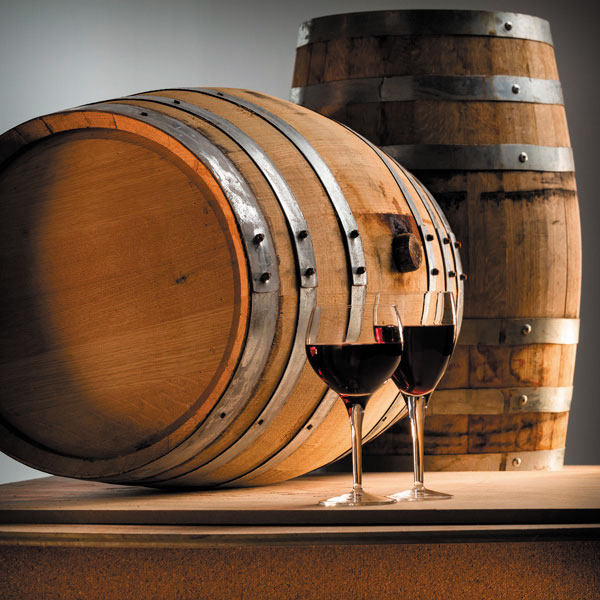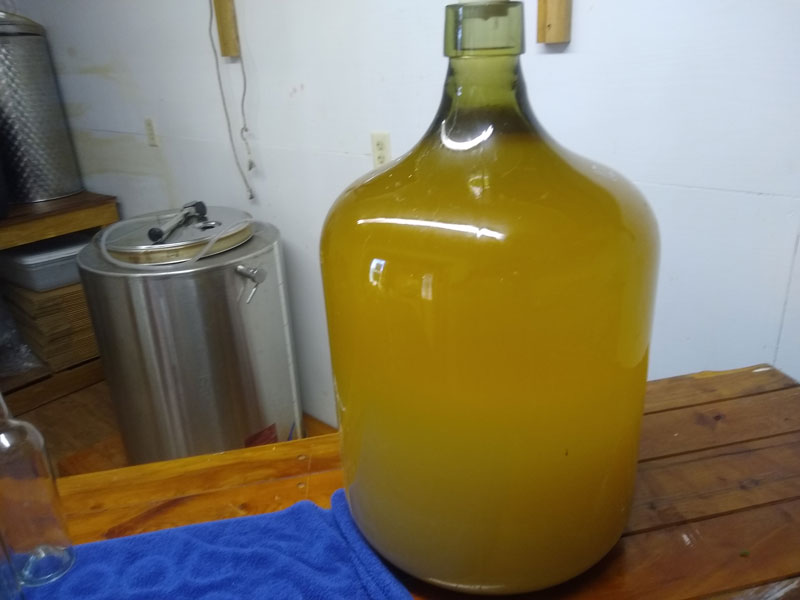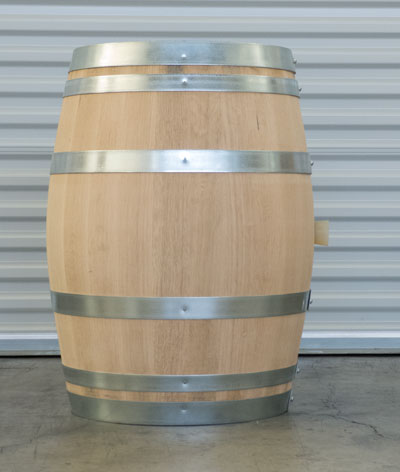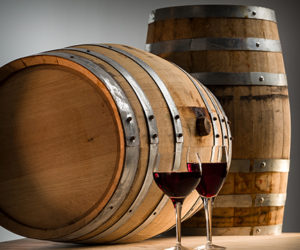Q Good day! I was not able to find how to preserve an oak barrel after its use. I have done four wine batches in it and now I feel that it’s not giving me the same effect as for taste. I would like to save the barrel and place it in my wine cellar, just do not want it to crack. Anything you can suggest?
Gates Legault
Sudbury, Ontario
A Well, the first thing I always say is, “A full barrel is a happy barrel.” That means that the barrel is best stored with wine in it! The acidity of the wine (generally reds tend to be a pH of 3.5–3.8-ish) keeps spoilage microbes at bay and of course the wetness of the wine keeps the wood nice and swollen. For those times when we can’t keep our barrels full of wine, however, we do need to have a backup plan. This is where a good barrel storage solution comes in.

Basically, what you’re going to do is fill your barrel with an acidulated sulfur dioxide solution, which mimics the above salubrious effects — don’t attempt to drink it, however! Here’s the recipe to keep one barrel:
-180 g of citric acid
-160 g of potassium metabisulfite (KMBS) powder
-Enough water to fill the barrel
Procedure: Fill your barrel about halfway with water. If possible, use a carbon-block filter to remove the chlorine from the water, as chlorine can contribute to TCA, or the “corked” aroma defect, which could infiltrate your barrel. The water could be warm or cold, but warm water will help the chemicals dissolve faster and more thoroughly. Do not use hot water, which will cause the sulfur dioxide in the KMBS powder to volatilize and potentially not only burn your nose-hairs off but also to dissipate more quickly. Put on a respirator that has cartridges that are NIOSH-approved for sulfur dioxide gas as well as eye protection. Dissolve the citric acid in about a gallon (4 L) of warm water and add to the half-full barrel. With your barrel-stirrer (you have one of those, right?) or a long dowel or rod, mix the solution into the water. By the way, you can use tartaric acid too, it’s just much more expensive than citric acid. Continue filling the barrel until it’s about ¾ of the way full. Then dissolve the KMBS powder into about a gallon (4 L) of water (warm water is OK here, just not hot), and add to the barrel, again mixing thoroughly. Completely top up the barrel with water. Top with a wooden bung or a bung you don’t care about ruining, as strong sulfur dioxide solutions (KMBS is 57.6% sulfur dioxide), liquid or gas, will degrade and crack silicone bungs over time. Another cellar trick is to cover your bung with plastic wrap before sealing up the barrel.
For those times when we can’t keep our barrels full of wine, however, we do need to have a backup plan.
Practice good safety techniques at all times around sulfur dioxide, especially when acids and sulfur dioxide mix. SO₂ is much more effective at lower pHs, which is what you want, but that also renders it more volatile and dangerous. Flush any spills with plenty of clean water and don’t allow any un-masked people or your pets in the area while you’re working. By keeping your barrel filled with the above solution and by changing it out every one to two months, you should be able to keep your barrel sound and sweet when you don’t have wine in it. However, the best way to keep a barrel going is to keep it full of your aging wine . . . and to address one of your other comments, indeed after four batches of wine I would expect the barrel to not be contributing much flavor or aroma to the wine.
This is where I really like to add oak beans, sticks, or spirals to my wine in barrels. You get the benefit of the aging dynamics of the barrel and can add some more fresh wood for further flavor and aroma development. You can read about my recommended products here: https://winemakermag.com/wine-wizard/is-oak-sanitation-necessary
Q I was wondering if there was something that could be done for a batch of wine that has been over-sulfited? My wine has been bottled, so I won’t be doing any more rackings and I can’t give you specifics on how much I’ve over-sulfited as i don’t have the proper equipment to check it.
What I can tell you is I cleaned and tried to sanitize all the bottles with potassium metabisulfite (3 tablespoons for every 4 liters/1.1 gallons of water) but forgot to rinse the bottles before bottling. The wine is now very hard to drink and the sulfites are too harsh to handle. I also put in 9 mL of a 10% solution at the last racking . . . the carboy used holds only 20 liters (5.25 gallons) of wine.
Domenic Morda
Niagara-on-the-Lake, Ontario
A Since you can’t measure your free and total SO₂, let’s do some numbers to see what kind of a potential problem you might be facing. First off, let’s talk about your bottle-rinsing solution of 3 tablespoons per 4 liters of water. 3 tablespoons of KMBS (potassium metabisulfite) powder is equivalent to about 3 x 13 g (approximate weight of a tablespoon of KMBS), or 39 grams. Divide by 4 and your concentration is 9.75 g/L, or 0.975 g/100 mL, or 0.975%. That’s a pretty strong solution and let’s say that about 1 mL of that solution hung around in your wine bottle, which would contribute 0.00975 g of KMBS powder per bottle. Now, KMBS is only 57.6% sulfur dioxide, so then the full contribution is 0.0056 g, or 5.62 mg of total SO₂ per 750 mL bottle.
Let’s turn that into a language we’re more familiar with when talking about sulfur dioxide levels: ppm, or mg/L. If your bottles are 750 mL bottles that’s 0.75 L or 7.49 mg sulfur dioxide per liter of wine, 7.49 ppm. That’s not a huge addition, but if you already had a high level going into bottling, it certainly will add to it. As a point of reference, I typically like to bottle with a free (not total, which we’ve just calculated) SO₂ level of around 25–30 ppm, depending on the pH and the amount of SO₂ already in the wine. My total SO₂ at bottling (depending on the age of the wine and how many additions I’ve had to make over a wine’s lifetime) tend to hover around 75–125 ppm. As another reference point, the legal limit of total SO₂ in commercial wine in the U.S. is 350 ppm.
Now let’s look at how much SO₂ you added in your last addition, or 9 mLs of a 10% solution at your last racking. Your carboy is 20-L volume. A 10% solution can also be written as 10 g/100 mL, or 100 g/L. Since I don’t know whether you’re talking about a 10% solution as KMBS (which is 57.6% SO₂) or as SO₂, it’s hard to do the next step, but I’m going to assume you’ve got a 10% solution as KMBS. So, to 20 L of wine you added 9 mL of a 10 g/100 mL solution. In 1 of the mLs of your solution there are 0.1 g of KMBS, so you just added 0.9 g total, or 0.52 g of SO₂. In mg/L terms, you added 520 mg/20 L, or 26 ppm total as sulfur dioxide (not “free,” just “total” SO₂).
One of the challenges here is that I don’t know what the free and total SO₂ level of your wine was before that addition. If you’d been keeping your wine at about 25 ppm free SO₂, say for a year or so, and then added a total hit of 26 ppm on top of that, plus the 7.49 ppm leftover from your rinsing solution, it’s not too much of a stretch to think you could be looking at a free SO₂ of between 40–50 ppm, depending on the underlying chemistry of your wine. And indeed, that’s enough “extra” free SO₂ to where I could see you thinking the wine was a little hard to handle at the moment. You’re even in higher territory if you were talking about your 10% solution being “as sulfur dioxide,” in which case you’d be adding 900 mg/20 L, or 45 ppm total as sulfur dioxide.
So what can one do if one’s added too much sulfur dioxide to a wine? Since they’ve been all bottled up it’s a little hard to affect any kind of change, unless you want to open them all up and decant them . . . which you could do. My recommendation is to send a sample of the wine to be tested at your closest wine lab. Ask your local fermentation supply shop for contacts if you don’t have one already. I’d like you to actually see your free and total SO₂ numbers before you embark on any treatment because in this case sometimes the cure can be worse than the disease. If indeed you do have unnaturally high levels of free SO₂, how high it is will dictate my advice to you. If your free SO₂ is around 35–45 ppm and your total SO₂ is under 200 ppm, my advice is that you do nothing and just wait. The free SO₂ level will go down over time, so check on how a bottle tastes in another month or two. You might be pleasantly surprised.
If your free SO₂ is over 50 ppm and your total level is over 200 ppm, it’s unlikely that the wine will return to “drinkable” anytime soon. In which case, the best choice is to open all the bottles, decant (under a blanket of CO2 gas or argon to protect it from oxygen), and blend the over-sulfited wine with wine that has lower levels. This is a great solution . . . but only if you happen to have extra wine lying around that has lower levels of free SO₂. You may know that one of my mantras is “never blend a loser” but in this case the wine may be fine, it just needs its free SO₂ levels balanced out a bit. Before you blend, however, do send your prospective blenders out to a lab to measure their free and total SO₂ to see if the math even works out. It’s a good idea to have the free SO₂ going to bottle never be above 40 ppm, and ideally keep it between 25–35 ppm, depending on the pH of the wine (high pH wines need more SO₂).
There are some people who say that over-sulfited wine can be treated with hydrogen peroxide, but as I’ve never done it and as hydrogen peroxide is a powerful oxidizer and can utterly ruin your wine, I don’t recommend it. Instead, I’d go with one of the approaches I’ve discussed. You don’t want to create an even bigger problem by trying to solve the first one when it’s possible that all you need to do is wait.
Since the earlier calculations don’t imply gross over-sulfiting here, I will mention one other possible sulfur-stink problem winemakers encounter . . . hydrogen sulfide (rotten egg odor). You could try a “penny test” or if you have any copper sulfate solution, pipette a drop of that into a glass with 50 mLs of wine to see if it helps. If either of those tests resolve the sulfur situation, you will then need to do a proper bench trial to determine what’s the smallest addition needed to solve the problem, then add that amount to the batch. For more instructions on this, check out my “Wine Wizard” column in the June-July 2021 issue or at https://winemakermag.com/wine-wizard/properly-adding-copper
Q I have a large 12-gallon (45-L) carboy (see photo below). There’s a film on the inside of the glass. I’ve cleaned with One Step and have tried to scrub inside with a bottle brush many times. I Cannot remove film. The carboy currently has wine in it, but you can see its size. Any help would be appreciated.
Steve Auer
Coos Bay, Oregon
A Wow, looks like you’ve got a serious case of “Ring Around the Carboy.” Thanks for sending in the picture, I always love it when readers do that because, especially in cases like these, it gives me a good visual to go from. I can see that pesky stain on the inside of the neck of your carboy. One Step is a great cleaner but I’m not so sure it’s strong enough for your purposes here, i.e. it won’t really help you get that film off.

If I were you, I’d make sure you had a stiff-bristled “carboy brush.” If your local homebrewing/fermentation supply store doesn’t have one, you can find one online by entering those terms into your search engine of choice. You want a brush with an angled handle and/or an angled brush, so you can get into every curve and corner of your fermentation vessels.
Rather than use One Step again, I’d use something that’s a stronger base, which will help to break up the residue around the neck area. A classic that I love is peroxycarb, which is the trade name for a basic (high pH) powder of sodium carbonate and sodium percarbonate, which also releases hydrogen peroxide when added to water. I suggest an overnight soak in a strong (about ¼– ½ cup powder to a gallon of water/16–32 mL powder to a liter of water) peroxycarb solution, followed by a hard scrub with your angled brush and then a rinse with acidulated water (like citric). If that doesn’t work you could try a little abrasive cleanser like Bar Keeper’s Friend or even Comet cleanser. Just don’t use anything with bleach! Always follow any basic cleaner with an acidulated water rinse, and then a regular water rinse, to make sure you’ve removed anything that might change a wine’s pH. You definitely don’t want any basic residue hanging around inside your carboy.
I’ve got a pretty good feeling that with an overnight peroxycarb soak you should be able to scrub off that film. If not then it might just be a permanent stain on the inside of your vessel. If a strong base solution won’t take it off and you’ve scrubbed up and down I’d just live with it. It’s unlikely that at that point it will dissolve off into your wine!
Q I’m just starting out making wine and I’m a little petrified of making some (OK, a lot) of mistakes as I go along. Do you have any advice?
Maria Latham
Duluth, Minnesota
A Winemaking is always a learning process and even those of us that have been doing this for a long time still learn a lot every harvest and all year-round! However, that being said, I do have some tidbits for new winemakers. In my Winemaker’s Answer Book I spell out what I think are probably the top five “Rookie Mistakes” that those new to winemaking are prone to make:
- Picking grapes too early or too late: Once you pick you can’t go back and the path to wine is already laid out before you. Pick your reds at 22 °Brix and you should make a rosé . . . wait for riper fruit to make a “proper” big red wine.
- Inappropriate must adjustment: You can make little tweaks by adding acid (if pH is too high), water (if too ripe), or, in the case of home winemakers, a little sugar if needed to boost alcohol. Overdo it, however, and you’ve just thrown the whole balance off.
- Not understanding the destructive power of oxygen: Oxygen can ruin wine, oxidizing its bright color and encouraging spoilage microbes. Always keep finished wine away from oxygen by keeping your aging containers fully topped up to minimize exposure. There are many small tricks to minimizing exposure to oxygen but topping up is the most important.
- Not understanding the constructive power of oxygen: Yeast need some oxygen while fermenting and it can help tannin development in young wines. Embracing oxygen early on while a wine is still producing carbon dioxide (which protects the headspace) is a good idea. Just make sure the wine is protected once it stops producing its own carbon dioxide gas or oxidation and spoilage may result.
- Keeping inadequate records: Did you make a wonderful wine? If you weren’t writing down what you were doing, you’ll never be able to recreate it! Similarly, if you don’t like what you did, you won’t know what to avoid doing next time.







